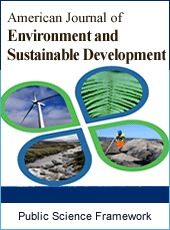American Journal of Environment and Sustainable Development
Articles Information
American Journal of Environment and Sustainable Development, Vol.4, No.1, Mar. 2019, Pub. Date: Mar. 5, 2019
Advances in Liquid Desiccant Integrated Dehumidification and Cooling Systems
Pages: 6-11 Views: 2035 Downloads: 1115
[01]
Jani Dilip Batukray, Department of Mechanical Engineering, GEC-Dahod, Gujarat Technological University (GTU), Ahmedabad, India.
The limitations of vapor compression based conventional systems in terms of substantial energy requirement for its running and environment pollution can arise the need of alternative cooling technology which is not only energy efficient but should be environmental friendly as well. Desiccant cooling is a suitable and cost-effective alternative which provides better thermal comfort conditions. This technology is cost effective, energy efficient, and eco-friendly. It will decrease the dependence on primary energy by an effective utilization of alternative, clean, free, and abundant sources of energy. The desiccant cooling is a thermally operated technology and is mostly used for dehumidification and cooling applications. Desiccant systems can either ant material used. The use of liquid desiccant material is advantageous as these can be regenerated at a lower temperature (60–75°C), which makes the use of low-grade thermal energy resources more feasible. In the present article liquid desiccant cooling systems have been discussed from the prospectus of its recent advancement, future research and development work needed. The pros and cons of the technology have also been discussed in the present work.
COP, Desiccant Cooling, Dehumidifier, Regeneration
[01]
Ahmed, S. Y, Gandhidasan, P. and Al-Farayedhi, A. A, (1998). Thermodynamic analysis of liquid desiccants, Solar Energy vol. 62, pp. 11-18.
[02]
Grossman, G., (2002). Solar-powered Systems for Cooling, Dehumidification and Air-conditioning, Solar. Energy vol. 72, pp. 53–62.
[03]
Yang, and Yan, W. J. (1992). Simulation study for an open-cycle absorption solar-cooling system operated in humid area. Energy Vol. 17 (7), pp. 649–55.
[04]
Factor, H. M, and Grossman, G. (1980). Packed bed dehumidifier/regenerator for solar air conditioning with liquid desiccants. Solar Energy Vol. 24 (6), pp. 541–50.
[05]
Elsayed, M. M, Gari, H. N, and Radhwan, A. M (1993). Effectiveness of heat and mass transfer in packed beds of liquid desiccant system. Renewable Energy Vol. 3: 661–8.
[06]
Li, X.-W., Zhang, X.-S., and Quan, S. (2011). Single-stage and double-stage photovoltaic driven regeneration for liquid desiccant cooling system. Applied Energy Vol. 88 (12), pp. 4908–4917.
[07]
Crofoot, L., and Harrison, S. (2012). Performance evaluation of a liquid desiccant solar air conditioning system. Energy Procedia Vol. 30, pp. 542–550.
[08]
Al-Abidi, A. A., Mat, S., Sopian, K., Sulaiman, M. Y., and Mohammad, A. Th. (2013). Experimental study of PCM melting in triplex tube thermal energy storage for liquid desiccant air conditioning system. Energy and Buildings Vol. 60, pp. 270–279.
[09]
Chen, Y., Yin, Y., and Zhang, X. (2014). Performance analysis of a hybrid air-conditioning system dehumidified by liquid desiccant with low temperature and low concentration. Energy and Buildings Vol. 77, pp. 91–102.
[10]
Buker, M. S., and Riffat, S. B. (2015). Recent developments in solar assisted liquid desiccant evaporative cooling technology review. Energy and Buildings Vol. 96, pp. 95–108.
[11]
Zheng, X., Ge, T. S., Jiang, Y. and Wang, R. Z. (2015). Experimental study on silica gel-LiCl composite desiccants for desiccant coated heat exchanger. International Journal of RefrigerationVol. 51, pp. 24–32.
[12]
Kim, M., Yoon, D., Kim, H., and Jeong, J. (2016). Retrofit of a liquid desiccant and evaporative cooling-assisted 100% outdoor air system for enhancing energy saving potential. Applied Thermal Engineering Vol. 96, pp. 441–453.
[13]
Rafique, M. M., Gandhidasan, P., and Bahaidarah, M. S. (2016a). Liquid desiccant materials and dehumidifiers – a review. Renewable and Sustainable Energy Reviews Vol. 56, pp. 179–195.
[14]
Rafique, M. M., Gandhidasan, P., Rehman, S., and Al-Hadhrami, L. M. (2016b). Performance analysis of a desiccant evaporative cooling system under hot and humid conditions Environmental Progress & Sustainable Energy Vol. 35 (5), pp. 1476–1484.
[15]
Jani, D. B., Mishra, M., and Sahoo, P. K. (2016). Solid desiccant air conditioning – A state of the art review. Renewable and Sustainable Energy Reviews Vol. 60, pp. 1451–1469.
[16]
Federico, B., and Furbo, S. (2017). Development and validation of a detailed TRNSYS Matlab model for large solar collector fields for district heating applications. Energy. DOI: 10.1016/j.energy.2017.06.146.
[17]
Jani, D. B., Mishra, M., and Sahoo, P. K. (2017). A critical review on solid desiccant based hybrid cooling systems. International Journal of Air-conditioning and Refrigeration Vol. 25, pp. 1-10.
[18]
Jani, D. B., Mishra, M., and Sahoo, P. K. (2018). A critical review on application of solar energy as renewable regeneration heat source in solid desiccant – vapor compression hybrid cooling system. Journal of Building Engineering Vol. 18, pp. 107-124.
[19]
Jani, D. B., Mishra, M., and Sahoo, P. K. (2018). Performance analysis of a solid desiccant assisted hybrid space cooling system using TRNSYS. Journal of Building Engineering Vol. 19, pp. 26-35.
[20]
Jani, D. B., Mishra, M., and Sahoo, P. K. (2018). Investigations on effect of operational conditions on performance of solid desiccant based hybrid cooling system in hot and humid climate. Thermal Science and Engineering Progress Vol. 7, pp. 76-86.
[21]
Jani, D. B., Lalkiya, D., and S. Patel. (2018). A critical review on evaporative desiccant cooling. International Journal of Innovative and Emerging Research in Engineering Vol. 5 (1), pp. 24-29.
[22]
Jani, D. B., Mishra, M., and Sahoo, P. K. (2018). Applications of solar energy. Springer, Singapore, ISBN 978-981-10-7205-5.

ISSN Print: Pending
ISSN Online: Pending
Current Issue:
Vol. 6, Issue 4, December Submit a Manuscript Join Editorial Board Join Reviewer Team
ISSN Online: Pending
Current Issue:
Vol. 6, Issue 4, December Submit a Manuscript Join Editorial Board Join Reviewer Team
| About This Journal |
| All Issues |
| Open Access |
| Indexing |
| Payment Information |
| Author Guidelines |
| Review Process |
| Publication Ethics |
| Editorial Board |
| Peer Reviewers |


